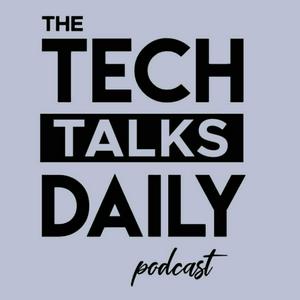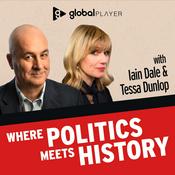Available Episodes
5 of 2233
- 3518: AWS re:Invent: The New Playbook For Detection, Response, And Secure AIHow do you move faster with AI and cloud innovation without losing control of security along the way? Recorded live from the show floor at AWS re:Invent in Las Vegas, this episode of Tech Talks Daily features a timely conversation with Kimberly Dickson, Worldwide Go-To-Market Lead for AWS Detection and Response Services. As organizations race to adopt agentic AI, modernize applications, and manage sprawling cloud environments, Kimberly offers a grounded look at why security must still sit at the center of every decision. Kimberly explains how her role bridges two worlds at AWS. On one side are customers dealing with prioritization fatigue, fragmented security signals, and growing pressure to do more with fewer resources. On the other hand, there are the internal service teams building products like Amazon GuardDuty, Amazon Inspector, and AWS Security Hub. Her job is to connect those realities, shaping services based on what customers actually struggle with day to day. That perspective sets the tone for a conversation focused less on hype and more on practical outcomes. We unpack how AWS thinks about security culture at scale, from infrastructure and encryption through to threat intelligence gathered across Amazon's global footprint. Kimberly shares how AWS uses large-scale honeypots to observe attacker behavior in real time, feeding that intelligence back into detection services while also working with governments and industry partners to take down active threats. It is a reminder that cloud security is no longer just about protecting individual workloads, but about contributing to a safer internet overall. The conversation also dives into new announcements from re:Invent, including the launch of AWS Security Hub, extended threat detection for EC2 and EKS, and the emergence of security-focused AI agents. Kimberly explains how these tools shift security teams away from manual investigation and toward faster, higher-confidence decisions by correlating risks across vulnerabilities, identity, network exposure, and sensitive data. The goal is clear visibility, clearer priorities, and remediation that fits naturally into existing workflows. We also explore how AWS approaches security in multi-cloud and hybrid environments, why foundational design principles still matter in an AI-driven world, and how open standards are helping normalize security data across vendors. Kimberly's reflections on re:Invent itself bring a human close to the episode, highlighting the pride and responsibility felt by teams building systems that millions of organizations depend on. As AI adoption accelerates and security teams are asked to keep pace without slowing innovation, what would it take for your organization to move faster while still trusting the foundations you are building on?--------28:12
- 3517: How Verdent AI is Building the Next Generation AI Coding Agents.In this episode of Tech Talks Daily, I sit down with Yuyu Zhang to unpack a shift that many developers can feel but struggle to articulate. Yuyu's journey spans academic research at Georgia Tech, building recommendation systems that power TikTok and Douyin at global scale, and leading the Seed-Coder project at ByteDance, which reached state-of-the-art performance among open source code models earlier this year. Today, he is part of Codeck, where the focus has moved beyond AI assistance toward autonomous coding agents that can plan, execute, and verify real engineering work. Our conversation begins with a simple but revealing observation. Most AI coding tools still behave like smarter autocomplete. They help you type faster, but they do not own the work. Yuyu explains why that distinction matters, especially for teams dealing with complex systems, tight deadlines, and constant interruptions. Autonomy, in his view, is not about replacing engineers. It is about giving them back their flow. We explore Verdent, Codeck's autonomous coding agent, and Verdent Deck, the desktop environment designed to coordinate multiple agents in parallel. Instead of one AI reacting line by line inside an editor, these agents operate at the task level. They plan work with the developer upfront, execute independently in safe environments, and validate their output before handing anything back. The result feels less like using a tool and more like managing a small engineering team. Yuyu shares how parallel agents change both speed and predictability. One agent can implement a feature, another can write tests, and another can investigate logs, all without stepping on each other. Just as important, he walks through the safeguards that keep humans in control. Explicit planning, permission boundaries, sandboxed execution, and clear, reviewable diffs are all designed to address the very real concerns engineering leaders have about letting autonomous systems near production code. The discussion also turns personal. Having worked on some of the highest-scale systems in the world, Yuyu reflects on why developers lose momentum. It is rarely about raw ability. It is about constant context switching. His goal with Verdent is to preserve mental focus by offloading interruptions and letting engineers return to work with clarity rather than cognitive fatigue. We close by looking ahead. The definition of a "good developer" is changing, just as it has many times before. AI is not ending programming. It is reshaping it, pushing human creativity, judgment, and design thinking to the foreground while machines handle the repetitive churn. If autonomous coding agents are becoming colleagues rather than helpers, how comfortable are you with that future, and what would you want to stay firmly in human hands?--------36:43
- 3517: How AWS and the PGA Tour Are Changing Live Sports TechnologyHow do you capture every moment of a golf tournament spread across hundreds of acres, tens of thousands of shots, and dozens of players competing at the same time? That question sits at the heart of this conversation recorded at AWS re:Invent, where I sat down with Eric Hansen, VP of Product at the PGA Tour, and Elaine Chiasson, who leads the global golf team at AWS, to unpack how data and AI are reshaping the way fans experience the game. Eric explains why modern professional golf has more in common with Formula 1 than most people realize. Every ball struck, every position on the leaderboard, and every shift in momentum generates data that needs to be processed instantly. With more than thirty thousand shots across a single tournament and only a fraction of them shown on traditional broadcasts, the PGA Tour faces a constant challenge. How do you give fans context, insight, and a sense of presence when most of the action is never seen on screen? Elaine shares how AWS has helped the Tour build the foundation to answer that question. From migrating decades of video and shot data into the cloud to applying generative AI for automated commentary, language translation, and real time insights, this partnership goes far beyond infrastructure. Together, they are experimenting with automated camera switching, AI driven production workflows, and personalized fan experiences that surface the right information at the right moment, whether you are following the leaderboard or a single favorite player. The conversation also digs into trust and accuracy. Eric walks through how the PGA Tour validates AI generated commentary to ensure it stays aligned with the sport's standards, while Elaine highlights why operational discipline and governance matter just as much as innovation. They explore what hyper personalization looks like inside the PGA Tour app, how global broadcasts could evolve, and why the long term opportunity lies in making every shot matter for every fan. As live sports move toward a future shaped by data, automation, and AI agents working behind the scenes, this episode offers a clear look at what that transformation really involves. So as golf continues to blend tradition with technology, what kind of fan experience do you want to see next, and how comfortable are you with AI calling the shots? Useful Links Connect with Eric Hansen, VP of Product at the PGA Tour. Connect with Elaine Chiasson Learn more about AWS and PGA Tour Tech Talks Daily is sponsored by Denodo--------26:27
- 3516: Twilio's Vision For AI First Engagement And The Rise Of Context Driven InteractionsHow do you make sense of an industry that is changing at a pace few predicted, especially with SIGNAL London still fresh in our minds and Twilio unveiling the next stage of its vision for customer engagement? That question sits at the heart of today's conversation with Peter Bell, VP of Marketing for EMEA at Twilio, who joined me to unpack what the past year has taught both companies and consumers about AI's role in shaping modern experiences. Peter begins by grounding everything in a single, striking shift. Only a year ago, AI-powered search barely registered in global traffic. Today it accounts for around a fifth of all searches. That leap signals a broader behavioral shift as consumers move instinctively toward conversational interfaces, which, in turn, leaves brands with a clear message. The clock has moved on. AI is no longer a nice-to-have. It is a direct response to how people now choose to discover, question, and buy. Our conversation turns to the gap between customer expectations and the experiences they receive. Peter discusses why brands often struggle to integrate channels, data, and AI coherently. He explains how first party data has become the anchor for any serious AI strategy, why generic public models cannot solve brand-specific tasks, and why the most successful teams start with simple, tightly scoped problems. A password reset may not sound glamorous, yet it is the kind of focused use case that teaches teams how to govern data, automate safely, and build confidence in the process. We also spend time on branded calling, RCS, and the evolution of voice. Peter breaks down what modern messaging now looks like and why trust sits at the center of every interaction. His explanation of Conversational Relay shows why natural voice exchanges finally feel within reach after years of frustration with rigid IVR systems. The thread running through all of this is clear. Consumers want speed and clarity, but they want reassurance too, and brands need to honor both sides of that equation. Later in the conversation, Peter makes one of the episode's most compelling points. Brand visibility has become harder, not easier, because much of the early research now occurs within AI tools. Buyers form opinions long before they speak with a sales rep. That shift explains why so many B2B companies are returning to high-impact brand channels, whether that is F1 sponsorships or other standout moments that keep them in the initial consideration set. We close with the topic that Peter believes will define the next stage of enterprise AI. Model Context Protocol. MCP has emerged as a quiet breakthrough, enabling LLMs to access data across CRM systems, files, and other software through a standard protocol. This removes one of the biggest blockers in AI projects: the practical challenge of connecting disparate data to a model built for a specific purpose. As Peter puts it, MCP gives companies a realistic way to make the special-purpose models that deliver reliable ROI. It is a wide-ranging conversation shaped by SIGNAL London's announcements, the evolving customer journey, and a year in which AI moved from curiosity to expectation. I would love to know what part stood out most to you. Are you seeing the same shifts Peter describes in your own business, and how are you preparing for the year ahead? Useful Links Interact with the Inside the Conversational AI Revolution report. Learn more about the Signal event Connect with Peter Bell, VP of Marketing for EMEA at Twilio. Tech Talks Daily is sponsored by Denodo--------28:37
- 3515: How Portnox Connects Cognitive Science With Access ControlWhy do smart people still click when every instinct tells them they should pause first? That question sits at the heart of this conversation with Denny LeCompte, CEO of Portnox and a rare cybersecurity leader who brings a background in cognitive psychology to identity, trust, and human error. It is a discussion that pulls back the curtain on the habits, shortcuts, and blind spots that shape our decisions long before a breach becomes a headline. Denny explains why people rely on benevolence cues, confirmation biases, and loss aversion, and then shows how attackers weaponize each. He explains why training alone cannot fix human fallibility and why a different design mindset is needed if we want security people can actually live with. Through clear examples and thought-provoking analogies, he describes how teams can build environments that remove opportunities for mistakes rather than punishing people for being human. We also explore what Zero Trust really means beyond marketing-speak. Denny cuts through the noise and frames it as a mindset shift rather than a product category. He draws on real conversations with CISOs to explain why passwordless adoption moves slowly and why the next wave of identity risk will come from AI agents operating within networks. It is a future in which the line between human and machine identity blurs, requiring access control to evolve just as quickly. Later, Denny shares a personal story about a mentor who influenced his views, then explains Portnox's unified access control approach as organizations retire VPNs and passwords. His main point: security only works when systems reflect human nature, removing friction and helping people make safe choices. Every policy and workflow is a decision that impacts security outcomes. What part of Denny's perspective made you reconsider your habits? Useful Links Connect with Denny LeCompte, CEO of Portnox Learn more about Portnox Tech Talks Daily is sponsored by Denodo--------30:25
More News podcasts
Trending News podcasts
About Tech Talks Daily
If every company is now a tech company and digital transformation is a journey rather than a destination, how do you keep up with the relentless pace of technological change?
Every day, Tech Talks Daily brings you insights from the brightest minds in tech, business, and innovation, breaking down complex ideas into clear, actionable takeaways.
Hosted by Neil C. Hughes, Tech Talks Daily explores how emerging technologies such as AI, cybersecurity, cloud computing, fintech, quantum computing, Web3, and more are shaping industries and solving real-world challenges in modern businesses.
Through candid conversations with industry leaders, CEOs, Fortune 500 executives, startup founders, and even the occasional celebrity, Tech Talks Daily uncovers the trends driving digital transformation and the strategies behind successful tech adoption. But this isn't just about buzzwords.
We go beyond the hype to demystify the biggest tech trends and determine their real-world impact. From cybersecurity and blockchain to AI sovereignty, robotics, and post-quantum cryptography, we explore the measurable difference these innovations can make.
Whether improving security, enhancing customer experiences, or driving business growth, we also investigate the ROI of cutting-edge tech projects, asking the tough questions about what works, what doesn't, and how businesses can maximize their investments.
Whether you're a business leader, IT professional, or simply curious about technology's role in our lives, you'll find engaging discussions that challenge perspectives, share diverse viewpoints, and spark new ideas.
New episodes are released daily, 365 days a year, breaking down complex ideas into clear, actionable takeaways around technology and the future of business.
Podcast websiteListen to Tech Talks Daily, The Rest Is Politics: Leading and many other podcasts from around the world with the radio.net app

Get the free radio.net app
- Stations and podcasts to bookmark
- Stream via Wi-Fi or Bluetooth
- Supports Carplay & Android Auto
- Many other app features
Get the free radio.net app
- Stations and podcasts to bookmark
- Stream via Wi-Fi or Bluetooth
- Supports Carplay & Android Auto
- Many other app features


Tech Talks Daily
Scan code,
download the app,
start listening.
download the app,
start listening.






































